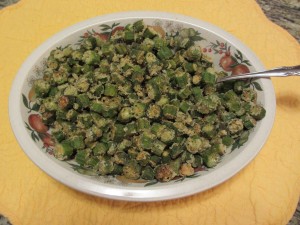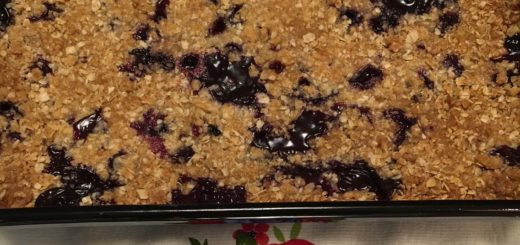August usually brings hot, dry weather which is perfect for growing okra. When it gets a little rain or watering, the okra takes off and produces a bounty crop, ready to be cut, cooked and enjoyed.
In my family, okra is fried, and is perhaps the one vegetable that everyone eats well. Since it is a seasonal vegetable, cooking it fresh has a limited time period, so we buy it in quantity and cook and freeze it for later. Here is a recipe for fried, not breaded, okra, and a tip on freezing it to enjoy year round.
Fried Okra
In a sink or a large bowl (depending on the quantity), rinse the whole okra in slightly warm water. Then move it to an adjoining sink or another bowl, also filled with slightly warm water, and rinse it again.
Remove the okra to an area, such as a dish drainer or mat, that is lined with several layers of paper towels. Let it drain as much as possible.
If the okra will not be cut right away, put it into a large plastic bag and refrigerate. It will stay crisp longer if it is rinsed before refrigerating.
To prepare the okra for cooking, remove the stem end and the small end (if you like), and cut it into small pieces.
It can be refrigerated at this point also, to await cooking.
Salt and pepper the cut pieces, then add corn meal and flour, toss to coat. This does not make a batter, but it does add a little crispness.
Heat vegetable oil in a pan (either coated or not) and add the cut okra when the oil is hot. Make it one or two layers, but not overloaded.
Cook the okra for personal preference, either light, medium or crispy. Stir a little to cook evenly. Different pans will make the okra cook differently, so experiment to find a pan that cooks it to your taste. And, experiment with temperature. I usually start at medium heat, then reduce if it is browning too quickly.
When cooked to the desired doneness, scoop the okra from the pan with a slotted spoon, and drain it on a pan or plate lined with paper towels.
If cooking more okra, add a little oil to the pan and reheat, then add the okra.
Freezing Okra
If freezing the okra is the plan when it is being cooked, consider not browning it as much as you might ordinarily. It will be cooked more later, and it will also brown then.
Drain and cool the cooked okra, then pour it into freezer zip-lock bags or plastic containers and freeze.
When ready to use the frozen okra, remove the preferred amount, and make one layer on non-stick aluminum foil placed in a baking pan. It will stick to regular aluminum foil and make removal difficult.
Cook it at 350 degrees until it is warm and the desired crispness (this is why you undercook it a little before freezing).
Enjoy it fresh or frozen as a tasty reminder of summertime!





